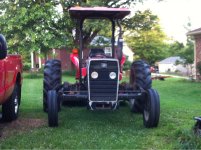rbtjr
Gold Member
Just saw this thread. I am very interested in the subject. We also have a L3800HST 4WD, but we have R4 tires, and the R4 wheels on a L3800 can't be adjusted for width. We previously had a M5700. When we first got the L3800, it was very unstable compared to its predecessor. Our rear tires are loaded but our front tires are not. We put 4" spacers on each rear wheel, and it made a lot of difference. Our dealer said that he had never seen or heard of anyone having problems as a result of adding rear wheel spacers. My only thought on wheel spacers for a L3800 is that more width would have been better but for us would have caused issues with getting the tractor placed properly on our trailer (the wheels would have been wider than the inside width of the trailer fenders--and yes, I know that I could have backed the tractor on the trailer, but I couldn't always do that with the assortment of attachments we might have on the tractor).
Even after almost two years I am still getting used to the L3800, so I don't have a definitive answer for the OP or anyone else about the degree of slope that I think I can mow safely. I mow with the FEL on but very low to the ground. I do know that I mow some slopes that are 15% or more without a lot of discomfort, but I mow slowly and am very careful about watching for rocks and such on the high side and holes or depressions on the low side. We have some slopes we mow that look similar to those in the pics posted by the OP. If I am judging the slope in those pics correctly, I mow equivalent slopes with a zero-turn 66" mower, which has a much, much lower center of gravity than the L3800. We have a pond that we mow around. I mow the bottom of the steep slopes on the pond dam and steep sides around the pond with a bush hog by backing the tractor down the slope to the water. It is pretty tedious but it works well and is safe if you stay on high alert about not mistaking reverse for forward when you are close to the water.
Even after almost two years I am still getting used to the L3800, so I don't have a definitive answer for the OP or anyone else about the degree of slope that I think I can mow safely. I mow with the FEL on but very low to the ground. I do know that I mow some slopes that are 15% or more without a lot of discomfort, but I mow slowly and am very careful about watching for rocks and such on the high side and holes or depressions on the low side. We have some slopes we mow that look similar to those in the pics posted by the OP. If I am judging the slope in those pics correctly, I mow equivalent slopes with a zero-turn 66" mower, which has a much, much lower center of gravity than the L3800. We have a pond that we mow around. I mow the bottom of the steep slopes on the pond dam and steep sides around the pond with a bush hog by backing the tractor down the slope to the water. It is pretty tedious but it works well and is safe if you stay on high alert about not mistaking reverse for forward when you are close to the water.

